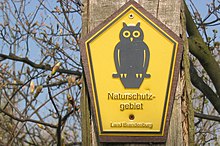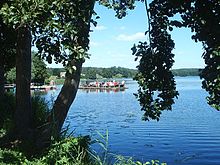Tourism in Brandenburg

The tourism in Brandenburg is determined by landscape, palaces and castles , as historically valid city centers , forests and water-rich protected areas with opportunities for shore leave , water sports , cycling and hiking . In 2012 the industry had over 60,000 employees and almost 11.5 million overnight stays.
The Brandenburger Lebuser Land on the Oder was chosen for 2003/2004 as the cross-border landscape of the year . The Havel was named River Landscape of the Year in 2004/2005 . Since 2001 is Tourism Award of Brandenburg awarded annually three to be particularly "creative" prestigious tourist offers, as "exemplary" and current projects as "innovative" the existing services in the tourism are excellent.
The Spreewald Biosphere Reserve and the Westhavelland Nature Park , which together with the adjacent Luch landscapes Rhinluch , Havelländisches Luch , Dossebruch and Jäglitzniederung form a coherent inland wetland, are examples of areas frequented by tourists.
With 3,087 lakes, Brandenburg is in third place of all federal states after Bavaria and Mecklenburg-Western Pomerania , with approx. 100,000 hectares, the water area takes up 13% of the total area of the state.
Historic city centers
The working group “Cities with historic city centers” of the state of Brandenburg lists 31 cities with old city centers.
Dam gate in Jueterbog , 15th century
Large protected areas
The nature reserve in Brandenburg is a high priority. In 2002, 15 large protected areas were designated in the country , including one as a national park , three as a biosphere reserve and eleven as a nature park . Overall, the large protected areas take up around a third of the country's area. There are also nature reserves and total reserves such as the Plagefenn in the Schorfheide-Chorin biosphere reserve between Liepe and Brodowin - even forestry and entry is prohibited here. Parts of the large protected areas and other Brandenburg landscapes and sights can be explored on hiking trails, some of which are well developed . In addition, there are newly established and easily navigable cycle paths, which, like the Gurken cycle path in the Spreewald biosphere reserve , bring the diverse natural environment in Brandenburg closer.
- 1 national park:
- Lower Oder Valley National Park (106 km²)
- 3 biosphere reserves:
- Elbe-Brandenburg river landscape biosphere reserve (533 km²)
- Schorfheide-Chorin Biosphere Reserve (1291 km²)
- Spreewald Biosphere Reserve (474 km²)
- 11 nature parks:
- Barnim Nature Park (750 km²)
- Dahme-Heideseen nature park (594 km²)
- Hoher Fläming Nature Park (827 km²)
- Märkische Schweiz nature park (204 km²)
- Niederlausitzer Heidelandschaft nature park (490 km²)
- Niederlausitzer Landrücke Nature Park (580 km²)
- Nuthe-Nieplitz Nature Park (623 km²)
- Uckermärkische Seen Nature Park (895 km²)
- Schlaubetal Nature Park (225 km²)
- Stechlin-Ruppiner Land Nature Park (1080 km²)
- Westhavelland Nature Park (1315 km²)
Regional parks
While national parks and nature parks are primarily committed to nature conservation, the historically younger regional parks around Berlin primarily serve a sustainable development of the city and the surrounding area, which with their strategy for the protection of open spaces focus on the areas of leisure and tourism. Eight regional parks in Brandenburg and Berlin endeavor under an umbrella association founded in 2003 to bring the scenic and cultural-historical characteristics of their regions closer to their own population and visitors - especially from the metropolitan region of Berlin / Brandenburg .
Hiking, sports and water
In Brandenburg there are 3400 km of signposted hiking trails available to hikers. This also includes the 374 km long 66 lakes regional park route around Berlin through all eight regional parks. In 2012 the German Hiking Day will take place in Fläming .
There are 2400 km of signposted cycle paths for cyclists. The longest cycle path is the Brandenburg Tour with over 1000 km , as well as the Flaeming Skate , a 230 km extended route with round courses for skaters.
Further tourist offers are over 100 riding stables , almost 350 riding clubs and over 5000 km of marked bridle paths. In addition, there are 20 providers of balloon rides , 17 golf courses (mostly with guest game regulations), 4 glider areas and 20 special landing sites such as sports airfields .
Further offers are two draisine routes on disused railway tracks. There are 3,087 lakes , 33,000 km of watercourses, 8,000 km of water for non-motorized watercraft such as canoes , and 1,600 km of water for motor boats .
Travel areas in Brandenburg and their sights
For tourism, Brandenburg is divided into 13 travel areas, which are not always congruent with the administrative structure in counties (see above).
Barnim
- Niederfinow boat lift
- Eberswalde zoological garden
- ecovillage Brodowin
- Schorfheide Wildlife Park
- Hiking area of the Gamengrund chain of lakes
- Werbellinsee
- Oberbarnimer Feldstein route
Dahme lake area
Elbe-Elster-Land
- Niederlausitzer Heidelandschaft nature park (partially)
- Briquette Factory Louise
- Plessa magpie mill
- Plessa power plant
- Saathainer rose garden
- Castles of Stechau, Elsterwerda , Doberlug , Martinskirchen , Uebigau
- St. Mary's Church (Herzberg)
- Miniature Park Elsterwerda
- The Heidehöhe with observation tower in Schraden (landscape) (highest topographical elevation in Brandenburg)
Potsdam
- Sanssouci Palace and Park
- Babelsberg Palace and Park
- New garden with Cecilienhof Palace
- Babelsberg Film Park
Flaming
- Eisenhardt Castle in Bad Belzig
- SteinTherme in Bad Belzig
- Kristalltherme Ludwigsfelde
- Rabenstein Castle
- Ziesar Castle in Ziesar with the museum for the Christianization of the Mark Brandenburg
- Wiesenburg Castle
- Zinna Monastery
- Wiepersdorf Castle
- Blankensee Castle , especially the Sudermann Park
- Flaming skate
- The medieval stone churches in many Fläming villages
- Museum village Glashütte in Baruth / Mark
- High Fläming art hiking trail
Havelland
- Brandenburg an der Havel (cathedral)
- Brickworks Museum Glindow
- Cistercian monastery Lehnin
- Tree blossom festival in Werder
- Caputh Castle , Caputh
- Einsteinhaus Caputh
- Paretz Castle
- School museum and castle in Reckahn
- Toy museum in the Havelland in Kleßen
- Ribbeck Castle
Märkisch-Oderland
- Buckow (Märkische Schweiz)
- Neuhardenberg Castle , Neuhardenberg
- Wulkow Castle
- Hiking area Forst Prötzel am Gamengrund with the Blumenthal
Lower Lusatia
- Niederlausitzer Heidelandschaft nature park (partially)
- Branitz Castle and Park in Cottbus
- Finsterwalder Castle
- Fortress with Senftenberg Castle
- Sallgast Castle
- Doberlug Castle
- Cistercian monastery "Dobrilugk" in Doberlug-Kirchhain
- Slavic castle Raddusch
- Niederlausitzer museum railway
- Weißgerbermuseum in Doberlug-Kirchhain
- East German Rose Garden Forst (Lausitz)
- International building exhibition Fürst-Pückler-Land
- Visitor mine overburden conveyor bridge F60
- Grünhaus post-mining nature reserve
- EuroSpeedway Lausitz
Prignitz
- Plattenburg , the largest moated castle in northern Germany near Bad Wilsnack (health resort)
- Clock tower of the sewing machine factory in Wittenberge
- Cistercian monastery Stift zum Heiligengrabe
Ruppiner Seenland

- Sachsenhausen Memorial and Museum in Oranienburg
- Ravensbrück memorial in Fürstenberg / Havel
- Mildenberg brickworks park
- Fontanestadt Neuruppin
- Oranienburg Castle and Park
- Rheinsberg Palace and Park
- Oven and ceramic museum in Velten
- Himmelpfort Monastery in Himmelpfort
Lake District Oder-Spree
The Oder-Spree lake district consists of the Märkisch-Oderland and Oder-Spree districts . The tourist umbrella organization of this region is the Tourismusverband Seenland Oder-Spree e. V. based in Bad Saarow.
- Bad Saarow
- Cistercian monastery Neuzelle
- Schlaubetal
Uckermark
- Historic old towns of Angermünde and Templin
- NABU nature experience center Blumberger Mühle
- Lower Oder Valley National Park
- City wall and Marienkirche in Prenzlau
- Theater ruin Boitzenburg monastery
- Uckermark Lakes
Spreewald
Statistical data
| Travel region | Overnight stays in accommodation establishments and on campsites (2009) |
Bed supply in accommodation establishments without campsites (2009) |
Bed occupancy of the accommodation establishments without campsites (2009, in percent) |
|---|---|---|---|
| Barnimer Land | 731.200 | 4.137 | 35.7 |
| Dahme lake area | 707,400 | 4,274 | 38.1 |
| Elbe-Elster-Land | 211,300 | 1,554 | 32.9 |
| Flaming | 980,800 | 7,711 | 33.5 |
| Havelland | 769,800 | 6,281 | 27.2 |
| Märkisch-Oderland | 736.200 | 4,565 | 42.3 |
| Lower Lusatia | 417,900 | 2,981 | 25.8 |
| Oder-Spree-Seengebiet | 1,229,500 | 9,709 | 30.6 |
| Potsdam | 831,000 | 5,098 | 42.7 |
| Prignitz | 277.100 | 2,030 | 30.7 |
| Ruppiner Seenland | 1,290,800 | 9,854 | 33.1 |
| Spreewald | 1,274,000 | 7.195 | 39.4 |
| Uckermark | 795.100 | 5,267 | 35.8 |
| Brandenburg | 10.252.100 | 70,656 | 35.2 |
See also
- List of cycle routes in Brandenburg
- Regional parks in Brandenburg and Berlin
- List of lakes in Brandenburg
- Brandenburg cuisine
Web links
Individual evidence
- ↑ Development and importance of the Brandenburg-specific clusters of food industry, plastics and chemistry, metal and tourism in the state of Brandenburg 2008 - 2012. (PDF) (No longer available online.) Archived from the original on September 3, 2014 ; Retrieved August 29, 2014 . Info: The archive link was inserted automatically and has not yet been checked. Please check the original and archive link according to the instructions and then remove this notice.
- ^ Brandenburg tourism - sustainable and innovative. (No longer available online.) Archived from the original on September 3, 2014 ; Retrieved August 29, 2014 . Info: The archive link was inserted automatically and has not yet been checked. Please check the original and archive link according to the instructions and then remove this notice.
- ↑ Tourism Barometer Annual Report 2010, Ostdeutscher Sparkassenverband











